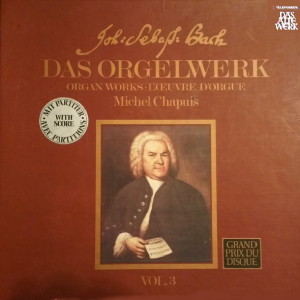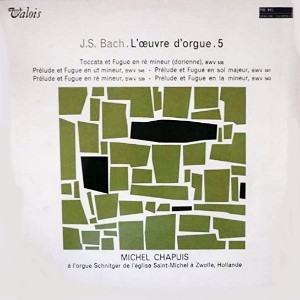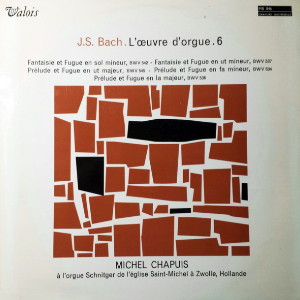 |
|
2 LP's
- BC 25100-T/1-2 - (p) 1968
|

|
| 1 LP -
Valois MB 845 - (p) 1968 |
 |
| 1 LP -
Valois MB 846 - (p) 1968 |
|
| DAS ORGELWERK -
VOL. 3 |
|
|
|
|
|
| Johann
Sebastian Bach (1685-1750) |
|
|
|
|
|
| Long Playing
1 - (Valois MB 845) |
|
|
| Präludium
(Toccata) und Fuge (dorisch)
d-moll, BWV 538 |
12' 54" |
|
| Präludium und
Fuge c-moll, BWV 546 |
10' 41" |
|
|
|
|
| Präludium und Fuge G-dur,
BWV 541 |
7' 05" |
|
| Präludium und Fuge d-moll,
BWV 539 |
7' 12" |
|
| Präludium und Fuge a-moll,
BWV 543 |
9' 10" |
|
Long Playing
2 - (Valois MB 846)
|
|
|
| Präludium und Fuge C-dur,
BWV 545 |
5' 08" |
|
| Präludium und Fuge f-moll,
BWV 534 |
7' 43" |
|
| Präludium und Fuge A-dur,
BWV 536 |
6' 33" |
|
|
|
|
| Präludium (Fantasie) und
Fuge g-moll,
BWV 542 |
11' 17" |
|
| Präludium (Fantasie) und
Fuge c-moll,
BWV 537 |
7' 49" |
|
|
|
|
| Michel Chapuis |
|
| an
der Arp Schnitger-Orgel
der St. Michaelis-Kirche,
Zwolle/Holland |
|
|
|
|
|
Luogo
e data di registrazione |
|
Zwolle
(Olanda) - marzo 1968 (LP 1) &
ottobre 1967 (LP 2) |
|
|
Registrazione: live /
studio |
|
studio |
|
|
Producer / Engineer |
|
Michael
Bernstein |
|
|
Prima Edizione LP |
|
- Valois
- MB 845 · Vol. 5 - (1 LP) -
durata 47' 02" - (p) 1968 -
Analogico
- Valois - MB 846 · Vol. 6 - (1
LP) - durata 38' 30" - (p) 1968 -
Analogico
|
|
|
"Das Orgelwerke" LP |
|
Telefunken
- BC 25100-T/1-2 - (2 LP's) -
durata 47' 02" / 38' 30" - (p)
1968 - Analogico |
|
|
Note |
|
- |
|
|
|
|
|
Preludes
and Fugues
Toccata, fantasia, prelude
and fugue are old forms of
instrumental music,
particularly piano and organ
music, going back to the
early 16th century;
nevertheless it was left to
Bach to give them that
artistic shape in which they
have since lived on as
patterns. This applies
especially to the prelude
and fugue as well as to
their combination into
complementary dual
movements. Their origins
consist of two contrary
principles of arrangement:
Free ranging, homophony,
virtuoso brilliance in the
toccata, in the prelude
related to it and the free
fantasy; as opposed to this,
strict thematic linking,
polyphony, build-up of the work
from imitative developments
with regard to the fugue.
The prelude and fugue were
originally intended to test
the tuning of the
instrument, to give the
other players or singers the
key and to prepare the
audience for the following
performance. These
introductory pieces were
improvised and developed
entirely according to the
mode of play of the
instrument: sustained chords
alternated with fast runs
and passage work. When
musicians began to compose
them properly and provide
scoring, more strictly
arranged, polyphonic
sections were also soon
incorporated. However, these
pieces always retained
something of the ranging
character in the
improvisation. The fugue on
the other hand goes directly
back to the vocal polvphony
of the 16th century. Its
preliminary forms, the
ricercare and the
instrumental canzona, were
initially instrumental
copies of the vocal
motets and the French
chanson.
A good deal of its varying
thematic process has been
maintained in the Bach fugue
subjects. Thus we
have in the present
selection, for instance, the
organ fugues in D minor BWV
538 and F minor BWV 534,
typical ricercare themes
which are hardly able to
deny their origins in the
motet. The G minor fugue BWV
542 on the other hand has
something of the rhythmic
drive and song-like
construction of the chanson.
In the ricercare and in the
canzona, just as in their
vocal prototypes, imitative
sections were joined on to
one another with the
appropriate new thematic
material. The decisive move
towards the fugue consisted
of the thematic unification
and broadening of the shape,
no longer by merely setting
out in a row, but by way of
harmonic and contrapuntal
methods, as well as by pithy
intermezzos. This was
introduced in the 17th
century, but it was only
Bach who finally consummated
it. In this respect the wide-ranging
modulation plan and the
clear separation of
developments and intermezzos
are inconceivable without
the example of the Italian
solo concertos, which
incidentally also played a
contributory part in
determining construction of
many preludes. Finally it
was also Bach who combined
the basically different
design forms of the prelude
(toccata) and fugue into a
firmly established dual
movement. Bach began his
music career at the age of
18 as organist. He
discovered his own style in
organ music, and it was for
the organ that he created
his earliest masterpieces.
Fuller details of his
artistic development, as
recorded in his analysis of
the traditionel forms of
organ music, are contained
in the notes with the fourth
album of Bach’s organ works.
The present third album
contains ten of the
large-scale preludes
(toccatas, fantasias) and
fugues arranged as dual
movements, including some of
the most famous. They cover
a period between about 1708
and 1740. The homogeneity of
the movement twosome in most
cases emerges strikingly
from their thematic
relation. More important
than this, however, is the
inner mutual dependency of
the two movements which no
doubt can only be described
more or less as the
principle of tension and
release.
Toccata and Fugue D minor
BWV 538 -- because of
the absence of the B
signature usual with the D
minor, erroneously
interpreted as church mode,
and called the “Doric
Toccata“ - is one of the
early master works und was
undoubtedly already composed
in the initial Weimar years,
between 1710 and 1714. The
introductory toccata
displays the influence of
the Italian concerto
movement, with its
alternation from tutti to
solo passages. Bach laid
down to the last detail in
this one case the manual
change between swell-organ
and positive. In this regard
it is a sound and not a thematic
change. The purpose is to
keep alive and further
consolidate the powerful
semi-quaver motion which
is maintained throughout
the entire movement. In
the same irrevocable
manner the mighty,
expressive fugue moves on
towards its goal without
any resting point. Its
broadly based theme, with
suspensions and syncopes,
is counterpointed with two
retained counterparts and
frequently borne in close
harmony.
Prelude and Fugue C
minor BWV 546 were
not composed until Bach’s
Leipzig period, and hardly
before 1730. The stylistic
further development is
best recognized in the
prelude, incorporating
thematic abundance and
concurrent fantasy into
lucid construction, which
again is based on a
concerto movement. In this
case ritornello and outer
movement are also
thematically clearly
distinguished. The long,
multilinked introductory
ritornello, which is
repeated at the end,
develops by way of the
three organ points of the
tonic, dominant and
subdominant, as the
evolution from a brief
thematic nucleus, the
suspension motif. Then, in
a grand harmonic curve,
follow the outer movement
and ritornello in a triple
change, being shortened,
modified and extended - a
section of the outer
movement is even worked
into the penultimate
ritornello. After this so
rich and complex movement,
the five-part fugue is
especially effective
because of the compelling
power of its unusual
subject. Its compact
movement is loosened up
with long minor part
intermezzos.
Prelude and Fugue G
major BWV 541 is one
of the few free organ
works which have been
passed on in Bach’s own
handwriting, a fair copy
from the 1740’s.
The composition itself was
most probably written 20
years earlier. The prelude
opens with a long solo
figure, establishing a
ritornello-type tutti
block which -- interrupted
by short solo passages -
continues in the same
vein. Starting from
rhythmical organ point D
the conclusion is reached
without a great deal of
digression. It is a
concise piece, of
breath-taking joy. This
jubilation carries on in
the fugue. The
introductory tone
repetitions of its theme
should not be construed in
the sense of the
hammering, knocking
battaglia motifs of the
North German organ school,
but of joyful, inner vitality.
Prelude and Fugue D
minor BWV 539 were
evidently not included in
the complementary set
sequence until the 19th
century. The fugue is
well-known as the 2nd
movement of the violin
solo sonata G minor, BWV
1001/2. The present
transcription for the
organ, an effective piece
featuring strong chords,
is more likely to have
been by one of the sons or
pupils of Bach than by
himself. Supporting this
theory are not only
stylistic reasons, but
also the tradition, which
did not begin until the
end of the 18th century.
It is improbable that the
modest prelude, to be
played only on the
manuals, belonged to it
from the outset. According
with contemporary
performance practice,
Michel Chapuis plays the
continuous quavers of the
prelude as “notes
inégales“, i.e., in
pointed rhythm. By way of
such movements our
attention is drawn to the
arrangement techniques
generally observed in
Bach’s time and applied by
Bach himself in a masterly
fashion; they are never
insignificant movements
prepared for another
instrument in this manner.
Prelude and Fugue A
minor BWV 543 no
doubt already originate
from the Weimar period,
although their tradition
does not begin until very
much later. In two widely
projecting passages, of a
definite toccata-type
shape, the prelude
prepares the extensive
fugue. The first is a
figurative solo which
intensifies by way of an
organ point extending over
23 bars. The second, also
starting as a figurative
solo, completes this
intensification with the
aid of a more
tightly-knit, chordic
imitative movement. The
fugue develops from a
high-spirited theme in 6/8
time into a virtuoso piece
with long intermezzos and
a toccata-like conclusion.
That the musical current
in this movement largely
consisting of sequences
does not dry up is
probably due, on the one
hand, to the artistic
theme whose pre-movement
continually keeps alive
the regular flow of motion
by shifting the rhythmic
points of emphasis, and on
the other hand to the
ingenious puzzle game
carried on with deceptive
developments emerging from
the intermezzos.
Prelude and Fugue C
major BWV 545 belong
to Bach’s Weimar period.
The autograph, which still
existed around 1900, has
disappeared. A shorter
version of the prelude
shows that this
toccata-type movement only
received by the addition
of three bars in front and
behind that compulsive,
balanced form in which it
is still presented today.
The fugue lives entirely
from the force of its
theme, stretching from
triple onset of speech to
the octave, the rear set
of which simultaneously
counterpoints the fore set
in opposing motions. It
is, however, more quickly
ended than one would
expect, precisely on
account of this theme.
Perhaps this is on account
of the succeeding largo
which
in some instances is
placed after the fugue and
which otherwise we know as
the centre movement of the
5th organ trio, BWV 529.
Prelude and Fugue F
minor BWV 534 has
come down to us in only
one copy from the early
19th century: evidence of
how many coincidences the
passing on of even highly
significant works was
dependent upon. The
composition probably
originates from the Weimar
period. The two-part
prelude is built up as
continuation from the
toccata-like semi-quaver
figuration over the organ
point. The fugue contains
a good deal of
chromaticism and
cross-relations. Even its
theme is dominated by the
diminished seventh leap
downwards. After the first
extended and tightly-woven
development part,
intermezzos alternate with
only brief thematic
sections in order to
enable the last theme
onset in the bass and alto
to come to the fore all
the more effectively.
There is only an early version
of the Prelude and
Fugue A major BWV 536
which apparently goes back
to the Arnstadt period.
Subsequently Bach
considerably rearranged
the prelude, and
transposed the fugue from
its original 3/8 time to
3/4; but apart from
increasing the note values
and shortening the
conclusion by two bars he
scarcely changed anything
of the latter. The terse
prelude develops in
toccata style, initially
with rising and descending
triad figurations by way
of organ points, then in
imitative setting of this
figuration. The fugue is
concise but arranged with
continually alternating
counterpoint. Shortened
inserts in the centre
section give notice of the
close melodic lead which
heralds the concluding
section. In the graceful
song-like theme the
rhythmic points of
emphasis change from bar
to bar, so that a peculiar
hovering metre ensues. It
is hardly likely that
anybody would be able to
detect the proper rhythm
of the theme after hearing
it only once.
Fantasia and Fugue G
minor BWV 542 are
the boldest and
technically most difficult
pieces in the present
selection. They have
frequently been connected
with Bach’s application
for the organist’s post at
the St Jakobi
church in Hamburg in the
year 1720; the fugue, the
theme of which derives
from a Dutch folk song,
has been regarded as
homage to the elderly
Hamburg organist Jan
Adams Reinken. However, at
least the fantasia has
been passed on in
autographs from Bach’s
Weimar period.
Harmonically it is one of
Bach’s most courageous
pieces, and in this sense
absolutely comparable to
the “Chromatic Fantasia“.
In the manner of the old
toccata, figurative
passages alternate with
chordic and imitative. The
fugue is not only arranged
in virtuoso and
concertante style, but is
also constructed like a
concerto movement, with
the theme developments
taking over the role of
the tutti, and the
intermezzos that of the
solo. The two movements,
fantasia and fugue, were
handed down individually
in numerous autographs and
thus apparently not until
some years after
composition were combined
by Bach into a dual
movement.
Fantasia and Fugue C
minor BWV 537 again
were handed down in only
one manuscript, which,
however, gives no
indication as to the date
of composition. The
fantasia is related to the
early Baroque fantasia,
which as yet does not
raise free-ranging
concepts to a principle of
form, but in the style of
the motet and chanson
joins imitative sections
on to one another. Bach
constructs from this a
two-part reprise form. The
fugue too keeps to the
reprise form: its
conclusion is a prolonged
da capo of its exposition.
The centre section is made
independent by the
introduction of fresh
counterpoints. Bach
frequently used this form
of the “da capo fugue“ in
his organ and lute fugues
of the later Leipzig
period.
by Georg
von Dadelsen
English
translation by
Frederick A. Bishop
*
This critical and complete
stylistic survey of Bach’s
organ works is the third
part and will be continued
by further releases.
|
|
|
Johann
Sebastian Bach - DAS
ORGELWERK
|
|
|
|

